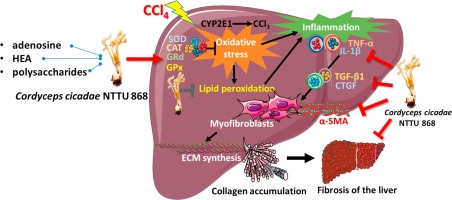Journal of Functional Foods ( IF 3.8 ) Pub Date : 2018-02-22 , DOI: 10.1016/j.jff.2018.02.010 Bo-Jun Ke , Chun-Lin Lee

|
Hepatic fibrosis is caused by chronic liver injury and repeated repair with scar tissue accumulation in the liver. Cordyceps cicadae produces large quantities of adenosine, N6-(2-hydroxyethyl)-adenosine (HEA) and polysaccharides. This study investigated the effect of C. cicadae NTTU 868 mycelium and its bioactive compounds on carbon tetrachloride (CCl4)-induced liver fibrosis. BALB/c mice were injected 0.5 µL/g CCl4 3 times weekly for 4 weeks to induce hepatic fibrosis and treated with C. cicadae NTTU 868 mycelium, adenosine, HEA, and polysaccharides daily for 6 weeks. CCl4 administration not only caused a remarkable liver damage but also resulted in abnormal collagen accumulation. C. cicadae NTTU 868 mycelium prevented CCl4-induced hepatic fibrosis through TNF-α/IL-6 pathway, TGF-β1/CTGF pathway, and anti-oxidative defense mechanism. Although adenosine, HEA and polysaccharides performed protection against CCl4-induced liver damage, HEA should be the main bioactive compound on the prevention of hepatic fibrosis in the C. cicadae NTTU 868 mycelium.
中文翻译:

虫草蝉NTTU 868菌丝体通过抑制促炎和促纤维化细胞因子的表达,预防CCl 4诱导的BALB / c小鼠肝纤维化
肝纤维化是由慢性肝损伤和由于瘢痕组织在肝脏中积累而引起的反复修复引起的。虫草蝉产生大量的腺苷,N6-(2-羟乙基)-腺苷(HEA)和多糖。这项研究调查蝉蝉NTTU 868菌丝体及其生物活性化合物对四氯化碳(CCl 4)诱导的肝纤维化的影响。每周3次,每周3次注射BALB / c小鼠0.5 µL / g CCl 4,以诱导肝纤维化,并每天使用蝉蝉NTTU 868菌丝体,腺苷,HEA和多糖处理6周。施用CCl 4不仅引起明显的肝损伤,而且还导致异常的胶原蛋白积聚。蝉科NTTU 868菌丝体通过TNF-α/ IL-6途径,TGF-β1/ CTGF途径和抗氧化防御机制预防了CCl 4诱导的肝纤维化。尽管腺苷,HEA和多糖对CCl 4引起的肝损伤具有保护作用,但HEA应该是预防蝉蝉NTTU 868菌丝体肝纤维化的主要生物活性化合物。











































 京公网安备 11010802027423号
京公网安备 11010802027423号